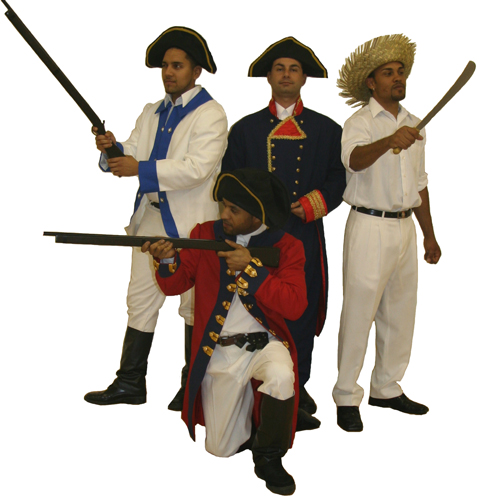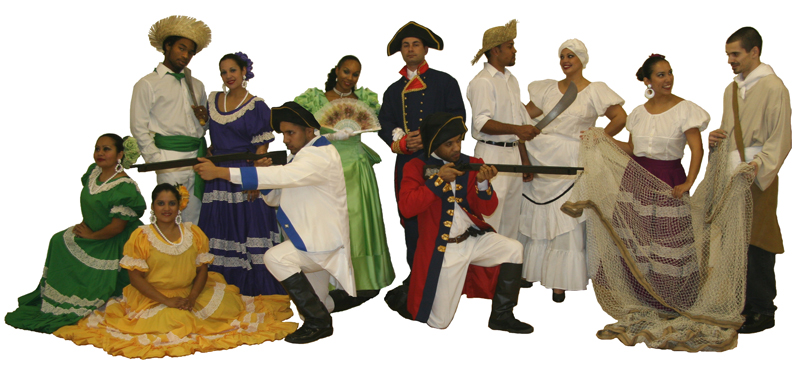












Puerto Rican Folkloric Dance

History behind the Musical
by Dr. Tekina-eiru Maynard (2005)
On Dec 11, 2005, the Puerto Rican Folkloric Dance performing company of
dancers and musicos were proud to debut our original mini-musical, written
by PRFDance Director Ana Maria Maynard, that
told the story of the heroism of the Puerto Rican people during the
British Invasion of 1797. We hope you enjoy reading this history behind our
production. Historical references are included below,
including research contributed
by Professor Juan A. Guisti Cordero, Univeristy of Puerto Rico.
Photos from that show coming soon!
The British Invasion of 1797
On April 17, 1797, urgent smoke signals from Loiza warned the San Juan Forts
of the arrival of the British fleet. Led by General Ralph Ambercromby,
the invasion brought more than 7000 British soldiers in over 60 ships
for what the British thought would be an easy victory -- the conquest of
Puerto Rico. Puerto Rico was in no way equipped to defend itself against
such a force: the majority of the trained spanish soldiers and arms
had been sent off to a campaign in Santo Domingo. There were less than
200 soldiers left guarding the fort!
The British fleet anchored off Cangrejos Point, in Pinones, a few miles east of the walled
city of San Juan. 3,000 troops landed to take control of Cangrejos and surround San Juan
by land. But to their surprise, the British discovered Puerto Rico
was no easy prey. Advance rumors of the impending invasion gave the energetic
Governor Ramon de Castro time to mobilize the standing troops, summon
the native militia, and call on every able bodied citizen throughout the island.
The British discovered the heroism of the Puerto Rican people -- 20,000
in all -- farmers, fisherman, ordinary men and women who came from the mountains,
coastal towns, and cities to save the island with whatever they had,
machetes, lances, farming implements!
For two weeks the battles raged on. Centuries of construction
and repair of San Juan's fortresses provided the capitol city with a massive
stronghold. Relentless fire from the city's forts barred the British from
scaling the city walls. The militia prevented them from reaching the
capital on foot, while armed citizens kept them from food supplies.
On the morning of May 1st, instead of being greeted to the renewed
sounds of enemy fire, the Puerto Rican people woke to an eery silence.
The British had abandoned their camps during the night in what seemed a hurried
retreat that left large amounts of equipment, artillery and munitions, horses,
beds, rations and cookware behind. Following their trail, the Puerto Ricans
found the British embarking on their ships in great haste.
A popular legend by Coll y Toste tells of a miracle that caused the British
retreat: on the night of April 30th the Bishop of San Juan called the whole
city to come with lighted candles to participate in a night-long prayerful procession
through the city to ask St. Ursula and the Seven Thousand Virgins to save Puerto Rico.
By midnight the British took the ringing of church bells and growing
lights in the city for massive reinforcements from the countryside, and
returned to their ships in a hasty retreat.
In recognition of the peoples' heroism King Carlos IV bestowed the Seal of
Spain on the City and the people of Pinones were rewarded with ownership of the land they
lived on. The herosim of the Puerto Rican people during this invasion was historic,
not only because they saved Puerto Rico from a takeover that would have
completely changed their history. But more importantly because
this invasion formed a Puerto Rican conscious collective -- it was the moment
in history when the people began to identify the island as their own,
"Puerto Rico, Mi Patria."

References:
We would like to give special thanks to Juan Giusti Cordero, Professor of History at the
University of Puerto Rico, and Nelie Lebron Robles of Paracumbe who shared many insights
into the period as well as rare historical literature. Here is our full list of references:
- Alonso, Maria M, and Flores, Milagros,
"The Eighteenth Century Caribbean
& The British Attack on Puerto Rico in 1797," National Parks Service, 1997.
- Jimenez de Wagenheim, Olga, "Puerto Rico: An Interpretive History from
Pre-Columbian Times to 1900," Markus Wiener Pub., 1998.
- Morales Carrion, Arturo, "Puerto Rico: A Political and Cultural
History," W. W. Norton & Company, Inc., 1983.
- Sarcano, Francisco, "Puerto Rico: Una Historia Contemporanea,"
McGraw-Hill, 1999.
- Coll y Toste, Cayetano, "The Eleven Thousand Virgins", from
"Puerto Rican Tales: Legends of Spanish Colonial Times,"
Ediciones Libero, Mayaguez, Puerto Rico, 1977.
- Phelps de Cordova, Loretta, "Five Centuries in Puerto Rico,"
Publishing Resources, Inc., San Juan, Puerto Rico, 1998.
- Pico, Fernando, and Rivera Izcoa, Carmen, "Puerto Rico Tierra
Adentro y Mar Afuera: Historia y cultura de los Puertorriquenos,"
Ediciones Huracan, Rio Piedras, Puerto Rico, 1991.
- "Los Fuertes del Viejo San Juan," Guia Oficial Parque Nacional.
Division de Publicaciones del Servicio Nacional de Parques, 2002.
- Morales Carrion, Arturo, "Puerto Rico y La Lucha Por la
Hegemonia en el Caribe: Colonialismo y contrabando,
siglos XVI-XVIII", Editoral de la Universidad de Puerto Rico, 1995.
- Gonzalez Vales, Luis, "El ataque britanico a Puerto Rico de 1797 en la Gaceta
de Guatemala," Revista del Instituto de Cultural Puertorriquena, Octubre-Diciembre
1970.
- Morales Carrion, Arturo, "Puerto Rico and the Non Hispanic Caribbean: A Study
in the Decline of Spanish Exclusivism," Univeristy of Puerto Rico Press, 1952.
- Guisti Cordero, Juan A., "Pinones si se Acuerda: 200 Anos de la participacion
negra en la victoria sobre la invasion inglesa," Boletin de la Asociacion de
Residentes de Pinones/Comite 1979-1997, May 1997.
Last but not least, "un gran saludo" to our friends,
The Fixed Regiment of Puerto Rico.
Our PRFDance Director is proud to be included as one of the official "Damas del Regimiento Fijo de Puerto Rico."
We hold the banner high for Puerto Rico everyday!
Thank you in advance for your donation of any size!!
Become a SUSTAINING DONOR with a recurring MONTHLY donation!

Or DONATE through PAYPAL GIVING FUND (no fees are subtacted)!


For more information:
Dr. Ana María Tekina-eirú Maynard
Puerto Rican Cultural Center
Cultural Center Address: 701 Tillery Street #13,
Austin TX 78702-3738 (Map & Directions)
Mailing Address: 15228 Quiet Pond Court, Austin TX 78728-4555
Phone: +1.512.251.8122
Email: dance@prfdance.org
Web: www.prfdance.org
Facebook: www.facebook.com/prfdance
Copyright ©1997-2025 Puerto Rican Folkloric Dance, Inc. All rights
reserved. Terms of use.




